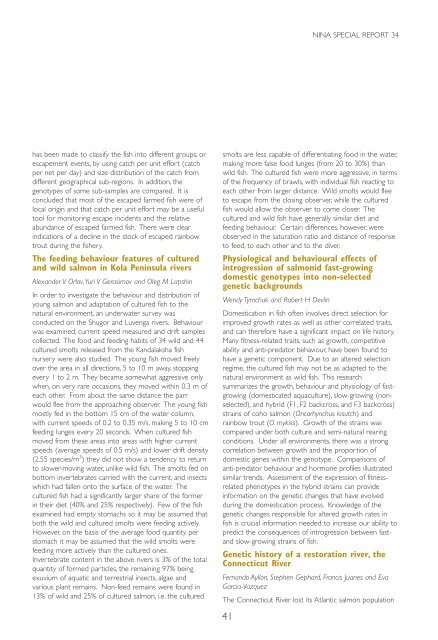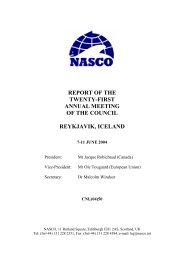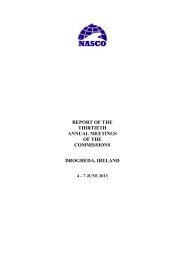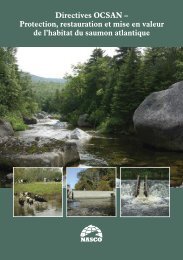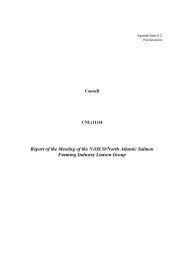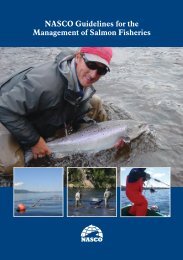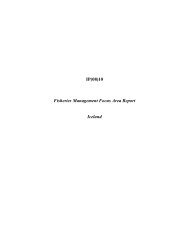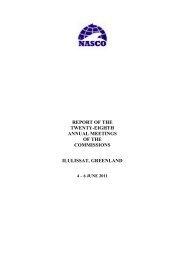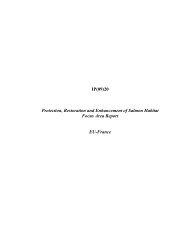Report of the 2005 ICES/NASCO Symposium on Interactions ...
Report of the 2005 ICES/NASCO Symposium on Interactions ...
Report of the 2005 ICES/NASCO Symposium on Interactions ...
Create successful ePaper yourself
Turn your PDF publications into a flip-book with our unique Google optimized e-Paper software.
NINA SPECIAL REPORT 34<br />
has been made to classify <str<strong>on</strong>g>the</str<strong>on</strong>g> fish into different groups, or<br />
escapement events, by using catch per unit effort (catch<br />
per net per day) and size distributi<strong>on</strong> <str<strong>on</strong>g>of</str<strong>on</strong>g> <str<strong>on</strong>g>the</str<strong>on</strong>g> catch from<br />
different geographical sub-regi<strong>on</strong>s. In additi<strong>on</strong>, <str<strong>on</strong>g>the</str<strong>on</strong>g><br />
genotypes <str<strong>on</strong>g>of</str<strong>on</strong>g> some sub-samples are compared. It is<br />
c<strong>on</strong>cluded that most <str<strong>on</strong>g>of</str<strong>on</strong>g> <str<strong>on</strong>g>the</str<strong>on</strong>g> escaped farmed fish were <str<strong>on</strong>g>of</str<strong>on</strong>g><br />
local origin and that catch per unit effort may be a useful<br />
tool for m<strong>on</strong>itoring escape incidents and <str<strong>on</strong>g>the</str<strong>on</strong>g> relative<br />
abundance <str<strong>on</strong>g>of</str<strong>on</strong>g> escaped farmed fish. There were clear<br />
indicati<strong>on</strong>s <str<strong>on</strong>g>of</str<strong>on</strong>g> a decline in <str<strong>on</strong>g>the</str<strong>on</strong>g> stock <str<strong>on</strong>g>of</str<strong>on</strong>g> escaped rainbow<br />
trout during <str<strong>on</strong>g>the</str<strong>on</strong>g> fishery.<br />
The feeding behaviour features <str<strong>on</strong>g>of</str<strong>on</strong>g> cultured<br />
and wild salm<strong>on</strong> in Kola Peninsula rivers<br />
Alexander V Orlov,Yuri V Gerasimov and Oleg M Lapshin<br />
In order to investigate <str<strong>on</strong>g>the</str<strong>on</strong>g> behaviour and distributi<strong>on</strong> <str<strong>on</strong>g>of</str<strong>on</strong>g><br />
young salm<strong>on</strong> and adaptati<strong>on</strong> <str<strong>on</strong>g>of</str<strong>on</strong>g> cultured fish to <str<strong>on</strong>g>the</str<strong>on</strong>g><br />
natural envir<strong>on</strong>ment, an underwater survey was<br />
c<strong>on</strong>ducted <strong>on</strong> <str<strong>on</strong>g>the</str<strong>on</strong>g> Shugor and Luvenga rivers. Behaviour<br />
was examined, current speed measured and drift samples<br />
collected. The food and feeding habits <str<strong>on</strong>g>of</str<strong>on</strong>g> 34 wild and 44<br />
cultured smolts released from <str<strong>on</strong>g>the</str<strong>on</strong>g> Kandalaksha fish<br />
nursery were also studied. The young fish moved freely<br />
over <str<strong>on</strong>g>the</str<strong>on</strong>g> area in all directi<strong>on</strong>s, 5 to 10 m away, stopping<br />
every 1 to 2 m. They became somewhat aggressive <strong>on</strong>ly<br />
when, <strong>on</strong> very rare occasi<strong>on</strong>s, <str<strong>on</strong>g>the</str<strong>on</strong>g>y moved within 0.3 m <str<strong>on</strong>g>of</str<strong>on</strong>g><br />
each o<str<strong>on</strong>g>the</str<strong>on</strong>g>r. From about <str<strong>on</strong>g>the</str<strong>on</strong>g> same distance <str<strong>on</strong>g>the</str<strong>on</strong>g> parr<br />
would flee from <str<strong>on</strong>g>the</str<strong>on</strong>g> approaching observer. The young fish<br />
mostly fed in <str<strong>on</strong>g>the</str<strong>on</strong>g> bottom 15 cm <str<strong>on</strong>g>of</str<strong>on</strong>g> <str<strong>on</strong>g>the</str<strong>on</strong>g> water column,<br />
with current speeds <str<strong>on</strong>g>of</str<strong>on</strong>g> 0.2 to 0.35 m/s, making 5 to 10 cm<br />
feeding lunges every 20 sec<strong>on</strong>ds. When cultured fish<br />
moved from <str<strong>on</strong>g>the</str<strong>on</strong>g>se areas into areas with higher current<br />
speeds (average speeds <str<strong>on</strong>g>of</str<strong>on</strong>g> 0.5 m/s) and lower drift density<br />
(2.55 species/m 3 ) <str<strong>on</strong>g>the</str<strong>on</strong>g>y did not show a tendency to return<br />
to slower-moving water, unlike wild fish. The smolts fed <strong>on</strong><br />
bottom invertebrates carried with <str<strong>on</strong>g>the</str<strong>on</strong>g> current, and insects<br />
which had fallen <strong>on</strong>to <str<strong>on</strong>g>the</str<strong>on</strong>g> surface <str<strong>on</strong>g>of</str<strong>on</strong>g> <str<strong>on</strong>g>the</str<strong>on</strong>g> water. The<br />
cultured fish had a significantly larger share <str<strong>on</strong>g>of</str<strong>on</strong>g> <str<strong>on</strong>g>the</str<strong>on</strong>g> former<br />
in <str<strong>on</strong>g>the</str<strong>on</strong>g>ir diet (40% and 25% respectively). Few <str<strong>on</strong>g>of</str<strong>on</strong>g> <str<strong>on</strong>g>the</str<strong>on</strong>g> fish<br />
examined had empty stomachs so it may be assumed that<br />
both <str<strong>on</strong>g>the</str<strong>on</strong>g> wild and cultured smolts were feeding actively.<br />
However, <strong>on</strong> <str<strong>on</strong>g>the</str<strong>on</strong>g> basis <str<strong>on</strong>g>of</str<strong>on</strong>g> <str<strong>on</strong>g>the</str<strong>on</strong>g> average food quantity per<br />
stomach it may be assumed that <str<strong>on</strong>g>the</str<strong>on</strong>g> wild smolts were<br />
feeding more actively than <str<strong>on</strong>g>the</str<strong>on</strong>g> cultured <strong>on</strong>es.<br />
Invertebrate c<strong>on</strong>tent in <str<strong>on</strong>g>the</str<strong>on</strong>g> above rivers is 3% <str<strong>on</strong>g>of</str<strong>on</strong>g> <str<strong>on</strong>g>the</str<strong>on</strong>g> total<br />
quantity <str<strong>on</strong>g>of</str<strong>on</strong>g> formed particles, <str<strong>on</strong>g>the</str<strong>on</strong>g> remaining 97% being<br />
exuvium <str<strong>on</strong>g>of</str<strong>on</strong>g> aquatic and terrestrial insects, algae and<br />
various plant remains. N<strong>on</strong>-feed remains were found in<br />
13% <str<strong>on</strong>g>of</str<strong>on</strong>g> wild and 25% <str<strong>on</strong>g>of</str<strong>on</strong>g> cultured salm<strong>on</strong>, i.e. <str<strong>on</strong>g>the</str<strong>on</strong>g> cultured<br />
smolts are less capable <str<strong>on</strong>g>of</str<strong>on</strong>g> differentiating food in <str<strong>on</strong>g>the</str<strong>on</strong>g> water,<br />
making more false food lunges (from 20 to 30%) than<br />
wild fish. The cultured fish were more aggressive, in terms<br />
<str<strong>on</strong>g>of</str<strong>on</strong>g> <str<strong>on</strong>g>the</str<strong>on</strong>g> frequency <str<strong>on</strong>g>of</str<strong>on</strong>g> brawls, with individual fish reacting to<br />
each o<str<strong>on</strong>g>the</str<strong>on</strong>g>r from larger distance. Wild smolts would flee<br />
to escape from <str<strong>on</strong>g>the</str<strong>on</strong>g> closing observer, while <str<strong>on</strong>g>the</str<strong>on</strong>g> cultured<br />
fish would allow <str<strong>on</strong>g>the</str<strong>on</strong>g> observer to come closer. The<br />
cultured and wild fish have generally similar diet and<br />
feeding behaviour. Certain differences, however, were<br />
observed in <str<strong>on</strong>g>the</str<strong>on</strong>g> saturati<strong>on</strong> ratio and distance <str<strong>on</strong>g>of</str<strong>on</strong>g> resp<strong>on</strong>se<br />
to feed, to each o<str<strong>on</strong>g>the</str<strong>on</strong>g>r and to <str<strong>on</strong>g>the</str<strong>on</strong>g> diver.<br />
Physiological and behavioural effects <str<strong>on</strong>g>of</str<strong>on</strong>g><br />
introgressi<strong>on</strong> <str<strong>on</strong>g>of</str<strong>on</strong>g> salm<strong>on</strong>id fast-growing<br />
domestic genotypes into n<strong>on</strong>-selected<br />
genetic backgrounds<br />
Wendy Tymchuk and Robert H Devlin<br />
Domesticati<strong>on</strong> in fish <str<strong>on</strong>g>of</str<strong>on</strong>g>ten involves direct selecti<strong>on</strong> for<br />
improved growth rates as well as o<str<strong>on</strong>g>the</str<strong>on</strong>g>r correlated traits,<br />
and can <str<strong>on</strong>g>the</str<strong>on</strong>g>refore have a significant impact <strong>on</strong> life history.<br />
Many fitness-related traits, such as growth, competitive<br />
ability and anti-predator behaviour, have been found to<br />
have a genetic comp<strong>on</strong>ent. Due to an altered selecti<strong>on</strong><br />
regime, <str<strong>on</strong>g>the</str<strong>on</strong>g> cultured fish may not be as adapted to <str<strong>on</strong>g>the</str<strong>on</strong>g><br />
natural envir<strong>on</strong>ment as wild fish. This research<br />
summarizes <str<strong>on</strong>g>the</str<strong>on</strong>g> growth, behaviour and physiology <str<strong>on</strong>g>of</str<strong>on</strong>g> fastgrowing<br />
(domesticated aquaculture), slow-growing (n<strong>on</strong>selected),<br />
and hybrid (F1, F2 backcross, and F3 backcross)<br />
strains <str<strong>on</strong>g>of</str<strong>on</strong>g> coho salm<strong>on</strong> (Oncorhynchus kisutch) and<br />
rainbow trout (O. mykiss). Growth <str<strong>on</strong>g>of</str<strong>on</strong>g> <str<strong>on</strong>g>the</str<strong>on</strong>g> strains was<br />
compared under both culture and semi-natural rearing<br />
c<strong>on</strong>diti<strong>on</strong>s. Under all envir<strong>on</strong>ments, <str<strong>on</strong>g>the</str<strong>on</strong>g>re was a str<strong>on</strong>g<br />
correlati<strong>on</strong> between growth and <str<strong>on</strong>g>the</str<strong>on</strong>g> proporti<strong>on</strong> <str<strong>on</strong>g>of</str<strong>on</strong>g><br />
domestic genes within <str<strong>on</strong>g>the</str<strong>on</strong>g> genotype. Comparis<strong>on</strong>s <str<strong>on</strong>g>of</str<strong>on</strong>g><br />
anti-predator behaviour and horm<strong>on</strong>e pr<str<strong>on</strong>g>of</str<strong>on</strong>g>iles illustrated<br />
similar trends. Assessment <str<strong>on</strong>g>of</str<strong>on</strong>g> <str<strong>on</strong>g>the</str<strong>on</strong>g> expressi<strong>on</strong> <str<strong>on</strong>g>of</str<strong>on</strong>g> fitnessrelated<br />
phenotypes in <str<strong>on</strong>g>the</str<strong>on</strong>g> hybrid strains can provide<br />
informati<strong>on</strong> <strong>on</strong> <str<strong>on</strong>g>the</str<strong>on</strong>g> genetic changes that have evolved<br />
during <str<strong>on</strong>g>the</str<strong>on</strong>g> domesticati<strong>on</strong> process. Knowledge <str<strong>on</strong>g>of</str<strong>on</strong>g> <str<strong>on</strong>g>the</str<strong>on</strong>g><br />
genetic changes resp<strong>on</strong>sible for altered growth rates in<br />
fish is crucial informati<strong>on</strong> needed to increase our ability to<br />
predict <str<strong>on</strong>g>the</str<strong>on</strong>g> c<strong>on</strong>sequences <str<strong>on</strong>g>of</str<strong>on</strong>g> introgressi<strong>on</strong> between fastand<br />
slow-growing strains <str<strong>on</strong>g>of</str<strong>on</strong>g> fish.<br />
Genetic history <str<strong>on</strong>g>of</str<strong>on</strong>g> a restorati<strong>on</strong> river, <str<strong>on</strong>g>the</str<strong>on</strong>g><br />
C<strong>on</strong>necticut River<br />
Fernando Ayll<strong>on</strong>, Stephen Gephard, Francis Juanes and Eva<br />
Garcia-Vazquez<br />
The C<strong>on</strong>necticut River lost its Atlantic salm<strong>on</strong> populati<strong>on</strong><br />
41


